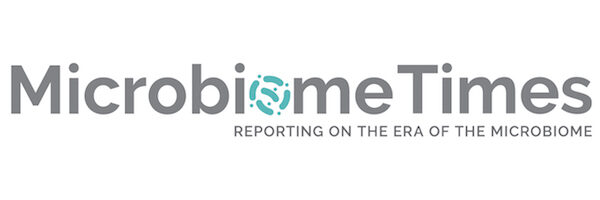
This summary of the 6th R&D and Business Collaboration Forum was authored by Anusha Gandhi from Microbiome Insights. The original version can be found here on their blog
Leaders in the microbiome industry met in San Diego (USA) for two days, on October 29th and 30th, 2018, to dive into the advancements in research and product development that have occurred to date. Microbiome Insights was an exhibitor at this event—The 6th Microbiome R&D and Business Collaboration Forum–one of the largest annual microbiome-related gatherings in the US, with 300 attendees coming from North America and Europe.
The conference talks were divided into three tracks: microbiome therapeutics, skin microbiome, and probiotics. Here, we present highlights from each of the tracks in this two-day event:
Day 1
Probiotics
Jennifer Spinler of Baylor College of Medicine spoke on “Targeting Antibiotic-Associated Digestive Diseases Using Next-Generation Probiotics”. She started by outlining the need for new therapies to prevent antibiotic-associated diarrhea. Clostridium difficile infection is one of the leading reasons for antibiotic administration, and a 2017 Cochrane Review showed probiotics can prevent Clostridium difficile-associated diarrhea in adults and children. Spinler’s approach is to explore a probiotic strategy for preventing Clostridium difficile infection in the first place by looking at how host bacteria are normally able to protect against C. difficile. She focused on Lactobacillus reuteri, which has anti-inflammatory effects and activity against Gram positive and Gram negative bacteria. She found that L. reuteri alone didn’t prevent the growth of C. difficile, but L. reuteri plus glycerol knocked down C. diff growth in the system—with an accompanying shift in the overall microbial community.
Brunella Gonzalez Cautela of Lallemand gave a talk on “Probio’Stick and the brain-gut axis: Focus on recent clinical findings”. She noted that the etiology of depression is obscure, but one contributor under consideration is immune-mediated inflammation. She thus posed the question: can probiotics be used for depression? A pilot study by the company, in collaboration with researchers from Queen’s University, focused on patients who were depressed but never treated before. In addition to completing a survey, the subjects were tested for inflammatory markers in the blood, serotonin levels, and fecal microbiome composition. Those who received ProbioStick for 8 weeks showed significant improvement in mood-related symptoms compared to those who received a placebo.
Microbiome
Kathy McCoy of University of Calgary presented on “Impact of the gut microbiome in shaping innate immunity: Defining Mechanisms”, going over several examples of using gnotobiotics to define mechanisms underlying microbiome and host interactions. In one example, researchers studied microbial impact on T Cells in a non-obese diabetic mouse model of type 1 diabetes. They looked at the ability of the bacteria to bring the integrase-specific T cells to the gut, and found that microbial antigens had a dramatic protective effect against colitis.
Jessica Schneider of Takeda Pharmaceuticals spoke about the company’s growing microbiome drug portfolio, and how gastrointestinal indications are paving the way for future indications (gut-brain axis and others). She explained the company’s interest in commensal bacterial co-occurrence networks in various disease states, and deriving effective therapeutics from these. Takeda is driven by the hypothesized mechanism of disease: either bugs as drugs, or (in the case of their collaboration with Enterome), drugs for/from bugs. She listed approaches in the industry, in increasing order of R&D complexity: fecal microbiota transplantation, bacteriophage engineering, bacterial consortia, engineered bacteria, single strain commensal bacteria, and small molecules.
Morten Isaksen of Bio-Me spoke on “Positioning microbiome analysis for use in precision medicine”. The company has developed a platform that does precision microbiome profiling (species/strain level) and direct quantification reads in less than a day. Isaksen described a demonstration study on diet: subjects consumed their normal diet for 4 weeks, then changed their diet in some way for the next 4 weeks—for example, consuming more fiber or changing sugar consumption. Bio-Me carried out daily sampling of fecal microbiota and found, interestingly, that after an initial microbiome change (after 3-5 days) there tended to be a rebound to pre-intervention levels of bacteria. Follow-up work will try to uncover the cause of this phenomenon.
Skin microbiome
Kausar Malik of Amway Corporation presented “The Cinco de Mayo Study: A one-year longitudinal study of the facial skin microbiome in normal healthy adults”—a project done in collaboration with the Microbiome Insights team. Malik described how bacterial species on the skin vary depending on the environment (e.g. moist or dry); the study aimed to find out the stability of the skin microbiome in a large population of healthy individuals over time, in order to begin identifying biomarkers of skin aging. In addition to skin swabs, they looked at red spots, wrinkles, brown spots, skin elasticity, barrier function, and surface pH. They found no significant change in alpha diversity over time, although some individuals showed a change in microbiome diversity on the cheek. Corynebacterium increased with age, and was also correlated with higher redness (in line with other published work).
Day 2
Microbiome
Eric Pamer of Memorial Sloan Kettering Cancer Center gave a keynote address on “Microbiota-mediated defense against intestinal infection”. His research focused on patients undergoing allogeneic hematopoietic stem cell transplantation (allo-HSCT): these patients receive antibiotics, chemotherapy, and radiation, and mortality is high in the case of bloodstream infection caused by vancomycin-resistant enterococcus (VRE). Given that the microbiome normally eliminates persistent VRE, the question is whether there’s a way to eliminate VRE in allo-HSCT patients. Pamer and colleagues showed that with a fecal transplant in these patients they re-established almost all the normal microbiome components—but which bugs were causing clearance of VRE? The researchers used particular bacteria and did a dilution test to examine the clearance of VRE. Blautia producta were the only bacteria that caused complete inhibition. When they looked into what Blautia producta expresses that none of the others do, they found it encodes a lantibiotic operon; these lantibiotics can also be expressed by anaerobes living in the colon.
Peter Spanogiannopoulos of UCSF was next up, with “The metabolism of fluoropyrimidine anticancer drugs by the human gut microbiome”. He cited work showing that Proteobacteria can inactivate 5FU—and noted that, fortunately, there is a lot about Proteobacteria in literature. He and his colleagues in the Turnbaugh lab are looking to answer the question: can probiotics rescue toxicity? One day they hope to sequence someone’s microbiome before administering anticancer drugs, in order to assess the pharmacokinetics.
Pierre Belichard of Enterome spoke on “Building the leading microbiome-derived immunotherapy company”. He explained that Enterome, a spin-out of MetaGenoPolis in France, is focused on determining function of the microbiome in cancer and inflammatory bowel disease. They are developing everything except ‘live biotics’—and their multiple programs are currently in various stages: for instance, glioblastoma and solid tumors (phase 1); Crohn’s disease (phase 2). They work on epitope mimicry to trigger an anti-tumor T-cell response, ‘waking up’ existing dormant T-cells in the gut lining to activate the biggest group of T cells in the human body. Their work in animal models has established this and they are now carrying it through in clinical trials with humans.
The next event in the microbiome track was a panel discussion led by Microbiome Insights CEO Malcolm Kendall: “Where the money is going and where the money will be made: The unique perspective of venture capitalists”. On the panel were Asish Xavier of J&J Innovation and Denise Kelly of Seventure. In response to an audience question, the panelists emphasized that they look carefully at every company that comes through the door; sometimes they ask for more information or progress and a company comes back later having secured a better position. Kendall asked the panelists the key things they look for in a company, and Kelly responded that the number one factor is top-notch science: validated and preferably peer-reviewed. Then comes intellectual property: who else is competing, and what makes the company different? Third is the business team and the research team. Xavier agreed, adding that the science may be very interesting but the key is whether it is translatable.
Timing is another factor: Xavier says he has seen companies take 20 years to bring something to market. He said timing is critical for a company—so sometimes he explores whether they can build a small product to bring to market while working on a larger one.
Kendall asked the panelists how they think microbiome science is progressing. Xavier acknowledged a lot of good science emerging—with an exponential number of publications—but not all of the ideas can be translated into a drug. The science only has potential as a company if you can get to phase 3 and beyond. Most times the drugs will be advanced by a bigger company because of regulatory challenges so the start-ups will have to partner at some point in their existence. Kelly agreed, and noted that over the past five years we have seen a massive capitalization of the scientific progress.

Anusha Gandhi
Senior Director Sales and Business Development

